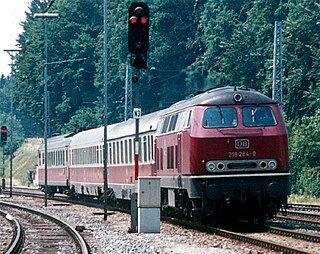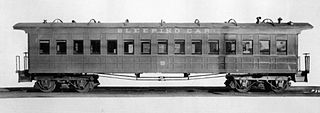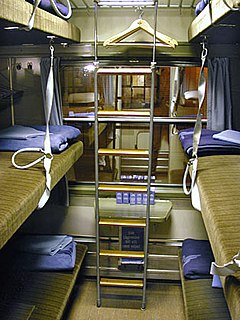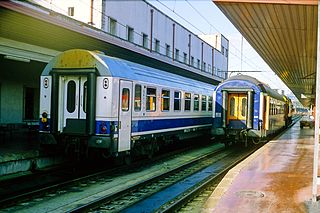
InterCity is the classification applied to certain long-distance passenger train services in Europe. Such trains generally call at major stations only.

Budapest Keleti (eastern) railway station is the main international and inter-city railway terminal in Budapest, Hungary.
EuroNight, abbreviated EN, denotes many main-line national and international night train services within the Western and Central European inter-city rail network.

The Děčín–Dresden railway, also called the Elbe Valley Railway is an electrified main line in Saxony and the Czech Republic. Formerly called the Saxon-Bohemian State Railway, the line is part of the Dresden to Prague route and is one of Europe's most important trunk routes (Magistralen). It runs along the Elbe Valley from Děčín via Bad Schandau and Pirna to Dresden. The first section of the line was opened in 1848 and is one of the oldest lines in Germany.

Kelenföld railway station is Budapest's fourth busiest railway station. Opened in 1861, it is situated south-west of the city centre, in Újbuda or District XI in the suburb Kelenföld.
Rail Cargo Austria (RCA) is an Austrian rail freight transportation company with its headquarters in Vienna. It was founded on 1 January 2005 as an independent company from the freight transport division of the ÖBB Group.

The Vindobona was an international named passenger train which began service in 1957 between Berlin and Vienna via Dresden and Prague. In later years the route was extended to run from Hamburg via Berlin, Dresden, Prague, Brno and Vienna to Villach. It was named after the ancient settlement of Vindobona on the site of the modern city of Vienna. Labelled as a EuroCity train connection from 1993, services discontinued in 2014.

The Bavaria was an express train that linked München Hbf in Munich, Germany, with Zürich HB in Zurich, Switzerland. Introduced in the 1950s, it ran through to Geneva until 1969, when it was cut back to Zurich. The train was named on the basis that Bavaria is the Latin equivalent to the German word Bayern, the official name of the federal state of Bavaria, of which Munich is the capital. It was operated by the Deutsche Bundesbahn / Deutsche Bahn (DB) and the Swiss Federal Railways (SBB-CFF-FFS). The route also included a single stop in Austria, at Bregenz. The 24 km (15 mi) section between Lindau, Germany, and St. Margrethen, Switzerland, is located mostly in Austria, but Swiss locomotives hauled the train over this section, most of which is part of the Vorarlberg line of Austrian Federal Railways.

The Helvetia was an express train that, for most of its existence, linked Hamburg-Altona station in Hamburg, Germany, with Zürich HB in Zurich, Switzerland. Introduced in 1952, it was operated by the Deutsche Bundesbahn / Deutsche Bahn (DB) and the Swiss Federal Railways (SBB-CFF-FFS). The train's name, Helvetia, is the Latin word for "Switzerland".
Progress was an express train between Prague, then the capital of Czechoslovakia, and the German Democratic Republic (GDR).
The Primator was an international express train. Introduced in 1986, it ran between Prague, then the capital of Czechoslovakia, and East Berlin, then the capital of the German Democratic Republic (GDR).
The Lehár was an express train between Budapest, Hungary, and Vienna, Austria. Introduced in 1979, it was the first eastern European train to become a EuroCity service, in 1988.
The Porta Bohemica is a EuroCity (EC) international express train. Since December 2014 it is operating between Hamburg-Altona and Budapest Keleti.
The Comenius has been the name of two distinct EuroCity (EC) international express trains, both of them originating, terminating or passing through Prague, the capital of the Czech Republic.

Budapest–Újszász–Szolnok railway line is the number 120a line of the MÁV. It is a double track, electrified track, which is part of the international rail system. It goes on as Line number 120, which connects Budapest, Békéscsaba, Lökösháza, Arad ]. The line from Budapest to Szolnok is 100 km long.

Szolnok is a railway station of the Hungarian State Railways (MÁV) in Szolnok, Hungary.


















